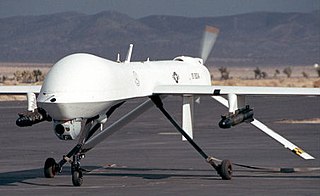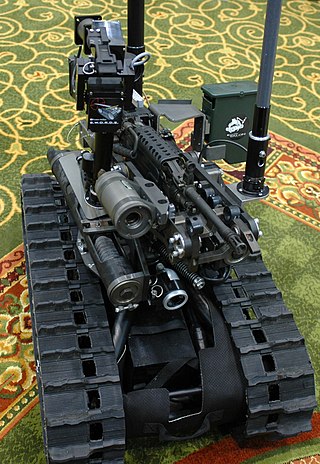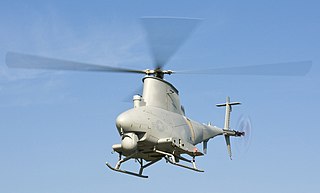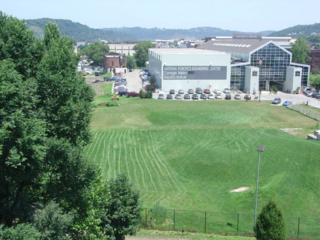
The iRobot R-Gator is an unmanned robotic platform from iRobot Corporation and John Deere.

The iRobot R-Gator is an unmanned robotic platform from iRobot Corporation and John Deere.
The 1,450 pounds (660 kg) robot is built upon Deere's M-Gator currently in use by the US Military. The R-Gator can operate autonomously, performing perimeter patrol and other missions while keeping personnel out of harm's way. [1] [2] It can operate autonomously by following a map or choosing its own waypoints to reach a pre-determined destination. It can also do "follow the leader" operations to keep up with troops, be tele-operated, or driven manually if needed. In military exercises, the R-Gator has shown an ability to carry gear for soldiers to lighten their loads. It also demonstrated its capacity to carry and drop off explosive ordnance disposal robots weighing more than 100 pounds (45 kg). An R-Gator could deploy the smaller machine and provide unmanned perimeter security while the EOD robot dismantles the bomb. The first R-Gator sale to the military was to the U.S. Navy Space and Naval Warfare Systems Command for autonomous perimeter security. [3]
An autonomous robot is a robot that acts without recourse to human control. The first autonomous robots environment were known as Elmer and Elsie, which were constructed in the late 1940s by W. Grey Walter. They were the first robots in history that were programmed to "think" the way biological brains do and meant to have free will. Elmer and Elsie were often labeled as tortoises because of how they were shaped and the manner in which they moved. They were capable of phototaxis which is the movement that occurs in response to light stimulus.

An unmanned aerial vehicle (UAV), commonly known as a drone, is an aircraft without any human pilot, crew, or passengers on board. UAVs were originally developed through the twentieth century for military missions too "dull, dirty or dangerous" for humans, and by the twenty-first, they had become essential assets to most militaries. As control technologies improved and costs fell, their use expanded to many non-military applications. These include aerial photography, area coverage, precision agriculture, forest fire monitoring, river monitoring, environmental monitoring, policing and surveillance, infrastructure inspections, smuggling, product deliveries, entertainment, and drone racing.

Military robots are autonomous robots or remote-controlled mobile robots designed for military applications, from transport to search & rescue and attack.

iRobot Corporation is an American technology company that designs and builds consumer robots. It was founded in 1990 by three members of MIT's Artificial Intelligence Lab, who designed robots for space exploration and military defense. The company's products include a range of autonomous home vacuum cleaners (Roomba), floor moppers, and other autonomous cleaning devices.

An unmanned ground vehicle (UGV) is a vehicle that operates while in contact with the ground and without an onboard human presence. UGVs can be used for many applications where it may be inconvenient, dangerous, or impossible to have a human operator present. Generally, the vehicle will have a set of sensors to observe the environment, and will either autonomously make decisions about its behavior or pass the information to a human operator at a different location who will control the vehicle through teleoperation.

PackBot is a series of military robots by Endeavor Robotics, an international robotics company founded in 2016, created from iRobot, that previously produced military robots since 1990. More than 2000 were used in Iraq and Afghanistan. They were also used to aid searching through the debris of the World Trade Center after 9/11 in 2001. Another instance of the PackBot technology being implemented was to the damaged Fukushima nuclear plant after the 2011 Tōhoku earthquake and tsunami where they were the first to assess the site. As of November 2014, the U.S. Army is refurbishing 224 iRobot 510 robots. The PackBot technology is also used in collaboration with NASA for their rovers and probes.

The Foster-Miller TALON is a remotely operated vehicle, and it is a small, tracked military robot designed for missions ranging from reconnaissance to combat. It is made by the American robotics company QinetiQ-NA, a subsidiary of QinetiQ.
The Denning Mobile Robot Company of Boston was the first company to offer ready-made autonomous robots that were subsequently purchased primarily by researchers. Grinnell More's Real World Interface, Inc. (RWI) and James Slater's Nomadic Technologies (US), along with Francesco Mondada's K-Team (Switzerland), were other pioneering companies in this field, addressing the need for ready-made robots for use by robotics researchers. RWI created the B-21, Nomadic the XR4000, whilst the tiny Khepera mobile robot emerged from the stables of the Swiss K-Team. However, the high price of these machines meant that only a few graduate students and military researchers could afford them. Eventually, the low-cost Pioneer robot was introduced in 1995, a project that expanded research in mobile robotics due to the affordable price.

The John Deere Gator is a family of small all-terrain utility vehicles produced by the John Deere Corporation. Gators typically feature a box bed, similar in function to a pickup truck. The bed can also be installed as an electric dump body. The John Deere Gator has been made in a variety of configurations, with either four, five or six wheels. The Gator line of vehicles are designed to serve on farms, worksites, and ranches, rather than as a pure off-road vehicle. However, it is possible to order with specific off-road features. Introduced in 1992, the vehicle replaced the five-wheeled John Deere AMT line introduced in 1987.

The Northrop Grumman MQ-8 Fire Scout is an unmanned autonomous helicopter developed by Northrop Grumman for use by the United States Armed Forces. The Fire Scout is designed to provide reconnaissance, situational awareness, aerial fire support and precision targeting support for ground, air and sea forces. The initial RQ-8A version was based on the Schweizer 330, while the enhanced MQ-8B was derived from the Schweizer 333. The larger MQ-8C Fire Scout variant is based on the Bell 407.

The XM1216 Small Unmanned Ground Vehicle (SUGV) is a Future Combat Systems specific, man packable version of the iRobot's PackBot.
Crusher is a 13,200-pound (6,000 kg) autonomous off-road Unmanned Ground Combat Vehicle developed by researchers at the Carnegie Mellon University's National Robotics Engineering Center for DARPA. It is a follow-up on the previous Spinner vehicle. DARPA's technical name for the Crusher is Unmanned Ground Combat Vehicle and Perceptor Integration System, and the whole project is known by the acronym UPI, which stands for Unmanned Ground Combat Vehicle PerceptOR Integration.
Squad Mission Support System is an unmanned all terrain wheeled vehicle developed by Lockheed Martin.
The iRobot Negotiator is an unmanned robotic platform from the iRobot Corporation. The 34 lb (15.4 kg) robot designed for use in civil response operations by civil defense professionals such as SWAT teams, police officers, etc.
The Seaglider is a deep-diving Autonomous Underwater Vehicle (AUV) designed for missions lasting many months and covering thousands of miles. In military applications the Seaglider is more commonly referred to as an Unmanned Underwater Vehicle (UUV).

The Ripsaw is a series of developmental unmanned ground combat vehicles designed by Howe & Howe Technologies for evaluation by the United States Army.
The Modular Advanced Armed Robotic System (MAARS) is a robot that is being developed by Qinetiq. A member of the TALON family, it will be the successor to the armed SWORDS robot. It has a different, larger chassis than the SWORDS robot, so has little physically in common with the SWORDS and TALON

The National Robotics Engineering Center (NREC) is an operating unit within the Robotics Institute (RI) of Carnegie Mellon University. NREC works closely with government and industry clients to apply robotic technologies to real-world processes and products, including unmanned vehicle and platform design, autonomy, sensing and image processing, machine learning, manipulation, and human–robot interaction.

A driverless tractor is an autonomous farm vehicle that delivers a high tractive effort at slow speeds for the purposes of tillage and other agricultural tasks. It is considered driverless because it operates without the presence of a human inside the tractor itself. Like other unmanned ground vehicles, they are programmed to independently observe their position, decide speed, and avoid obstacles such as people, animals, or objects in the field while performing their task. The various driverless tractors are split into full autonomous technology and supervised autonomy. The idea of the driverless tractor appears as early as 1940, but the concept has significantly evolved in the last few years. The tractors use GPS and other wireless technologies to farm land without requiring a driver. They operate simply with the aid of a supervisor monitoring the progress at a control station or with a manned tractor in lead.

As of January 2014, the United States military operates a large number of unmanned aerial vehicles : 7,362 RQ-11 Ravens; 990 AeroVironment Wasp IIIs; 1,137 AeroVironment RQ-20 Pumas; 306 RQ-16 T-Hawk small UAS systems; 246 MQ-1 Predators; MQ-1C Gray Eagles; 126 MQ-9 Reapers; 491 RQ-7 Shadows; and 33 RQ-4 Global Hawk large systems.